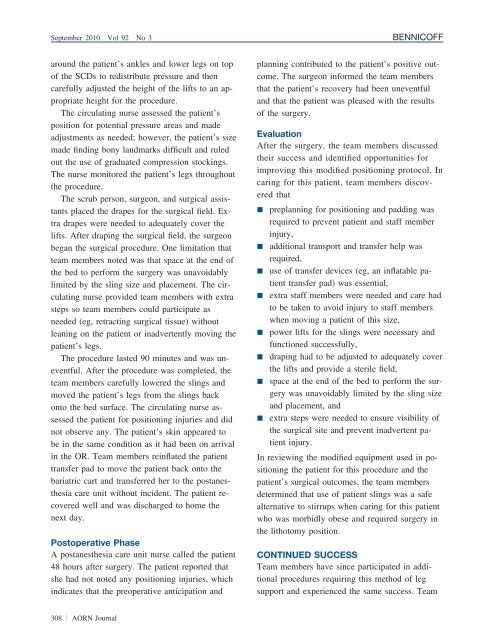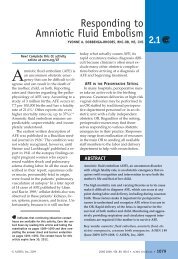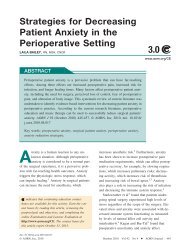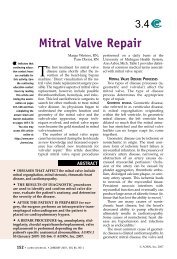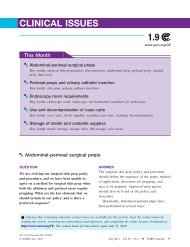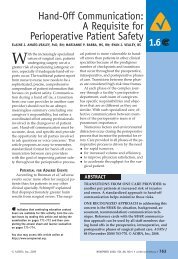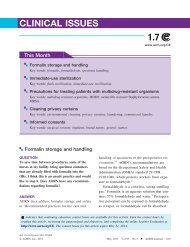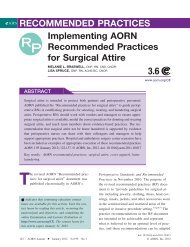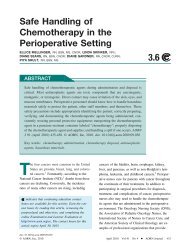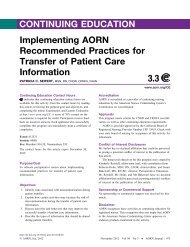Perioperative Care of the Morbidly Obese Patient in the ... - AORN
Perioperative Care of the Morbidly Obese Patient in the ... - AORN
Perioperative Care of the Morbidly Obese Patient in the ... - AORN
Create successful ePaper yourself
Turn your PDF publications into a flip-book with our unique Google optimized e-Paper software.
September 2010 Vol 92 No 3 BENNICOFFaround <strong>the</strong> patient’s ankles and lower legs on top<strong>of</strong> <strong>the</strong> SCDs to redistribute pressure and <strong>the</strong>ncarefully adjusted <strong>the</strong> height <strong>of</strong> <strong>the</strong> lifts to an appropriateheight for <strong>the</strong> procedure.The circulat<strong>in</strong>g nurse assessed <strong>the</strong> patient’sposition for potential pressure areas and madeadjustments as needed; however, <strong>the</strong> patient’s sizemade f<strong>in</strong>d<strong>in</strong>g bony landmarks difficult and ruledout <strong>the</strong> use <strong>of</strong> graduated compression stock<strong>in</strong>gs.The nurse monitored <strong>the</strong> patient’s legs throughout<strong>the</strong> procedure.The scrub person, surgeon, and surgical assistantsplaced <strong>the</strong> drapes for <strong>the</strong> surgical field. Extradrapes were needed to adequately cover <strong>the</strong>lifts. After drap<strong>in</strong>g <strong>the</strong> surgical field, <strong>the</strong> surgeonbegan <strong>the</strong> surgical procedure. One limitation thatteam members noted was that space at <strong>the</strong> end <strong>of</strong><strong>the</strong> bed to perform <strong>the</strong> surgery was unavoidablylimited by <strong>the</strong> sl<strong>in</strong>g size and placement. The circulat<strong>in</strong>gnurse provided team members with extrasteps so team members could participate asneeded (eg, retract<strong>in</strong>g surgical tissue) withoutlean<strong>in</strong>g on <strong>the</strong> patient or <strong>in</strong>advertently mov<strong>in</strong>g <strong>the</strong>patient’s legs.The procedure lasted 90 m<strong>in</strong>utes and was uneventful.After <strong>the</strong> procedure was completed, <strong>the</strong>team members carefully lowered <strong>the</strong> sl<strong>in</strong>gs andmoved <strong>the</strong> patient’s legs from <strong>the</strong> sl<strong>in</strong>gs backonto <strong>the</strong> bed surface. The circulat<strong>in</strong>g nurse assessed<strong>the</strong> patient for position<strong>in</strong>g <strong>in</strong>juries and didnot observe any. The patient’s sk<strong>in</strong> appeared tobe <strong>in</strong> <strong>the</strong> same condition as it had been on arrival<strong>in</strong> <strong>the</strong> OR. Team members re<strong>in</strong>flated <strong>the</strong> patienttransfer pad to move <strong>the</strong> patient back onto <strong>the</strong>bariatric cart and transferred her to <strong>the</strong> postanes<strong>the</strong>siacare unit without <strong>in</strong>cident. The patient recoveredwell and was discharged to home <strong>the</strong>next day.Postoperative PhaseA postanes<strong>the</strong>sia care unit nurse called <strong>the</strong> patient48 hours after surgery. The patient reported thatshe had not noted any position<strong>in</strong>g <strong>in</strong>juries, which<strong>in</strong>dicates that <strong>the</strong> preoperative anticipation andplann<strong>in</strong>g contributed to <strong>the</strong> patient’s positive outcome.The surgeon <strong>in</strong>formed <strong>the</strong> team membersthat <strong>the</strong> patient’s recovery had been uneventfuland that <strong>the</strong> patient was pleased with <strong>the</strong> results<strong>of</strong> <strong>the</strong> surgery.EvaluationAfter <strong>the</strong> surgery, <strong>the</strong> team members discussed<strong>the</strong>ir success and identified opportunities forimprov<strong>in</strong>g this modified position<strong>in</strong>g protocol. Incar<strong>in</strong>g for this patient, team members discoveredthat preplann<strong>in</strong>g for position<strong>in</strong>g and padd<strong>in</strong>g wasrequired to prevent patient and staff member<strong>in</strong>jury, additional transport and transfer help wasrequired, use <strong>of</strong> transfer devices (eg, an <strong>in</strong>flatable patienttransfer pad) was essential, extra staff members were needed and care hadto be taken to avoid <strong>in</strong>jury to staff memberswhen mov<strong>in</strong>g a patient <strong>of</strong> this size, power lifts for <strong>the</strong> sl<strong>in</strong>gs were necessary andfunctioned successfully, drap<strong>in</strong>g had to be adjusted to adequately cover<strong>the</strong> lifts and provide a sterile field, space at <strong>the</strong> end <strong>of</strong> <strong>the</strong> bed to perform <strong>the</strong> surgerywas unavoidably limited by <strong>the</strong> sl<strong>in</strong>g sizeand placement, and extra steps were needed to ensure visibility <strong>of</strong><strong>the</strong> surgical site and prevent <strong>in</strong>advertent patient<strong>in</strong>jury.In review<strong>in</strong>g <strong>the</strong> modified equipment used <strong>in</strong> position<strong>in</strong>g<strong>the</strong> patient for this procedure and <strong>the</strong>patient’s surgical outcomes, <strong>the</strong> team membersdeterm<strong>in</strong>ed that use <strong>of</strong> patient sl<strong>in</strong>gs was a safealternative to stirrups when car<strong>in</strong>g for this patientwho was morbidly obese and required surgery <strong>in</strong><strong>the</strong> lithotomy position.CONTINUED SUCCESSTeam members have s<strong>in</strong>ce participated <strong>in</strong> additionalprocedures requir<strong>in</strong>g this method <strong>of</strong> legsupport and experienced <strong>the</strong> same success. Team308 <strong>AORN</strong> Journal


